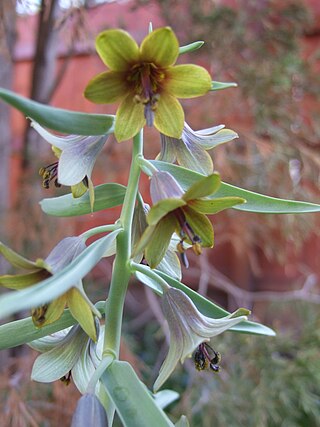
Salvia subgenus Perovskia is a group of species within the flowering plant genus Salvia, which prior 2017 were treated as the separate genus Perovskia. Members of the group are native to southwestern and central Asia. It includes the garden plant Russian sage.

Gagea is a large genus of spring flowers in the lily family. It is found primarily in Eurasia with a few species extending into North Africa and one species in North America.

Moluccella is a genus of annual and short-lived perennial plants native to Central and Southwestern Asia and the Mediterranean. They are tall, upright, branched plants growing to 1 meter or more with toothed leaves and small white fragrant flowers.
- Moluccella aucheri(Boiss.) Scheen - Iran, Pakistan
- Moluccella bucharica(B.Fedtsch.) Ryding - Uzbekistan
- Moluccella fedtschenkoana(Kudr.) Ryding - Uzbekistan and Tajikistan
- Moluccella laevisL. - Bells of Ireland - Turkmenistan, Iran, Iraq, Caucasus, Cyprus, Syria, Lebanon, Palestine, Turkey; naturalized in scattered locations in Europe, Africa, and North America
- Moluccella olgae(Regel) Ryding - Uzbekistan, Tajikistan and Kyrgyzstan
- Moluccella otostegioidesPrain - Pakistan
- Moluccella sogdiana(Kudr.) Ryding - Uzbekistan, Tajikistan
- Moluccella spinosaL. - Mediterranean from Spain + Algeria to Turkey + Palestine

Ixiolirion is a genus of flowering plants native to central and southwest Asia, first described as a genus in 1821. Recent classifications place the group in the monogeneric family Ixioliriaceae in the order Asparagales of the monocots. In earlier systems of classification, it was usually placed in the family Amaryllidaceae.

Leonurus (motherwort) is a genus of flowering plants in the family Lamiaceae. It is native to Europe and Asia, naturalized in New Zealand, Hawaii, New Caledonia, and much of North and South America.

Lallemantia is a genus of flowering plants in the family Lamiaceae. It is named after the German botanist Julius Léopold Eduard Avé-Lallemant.

Lagochilus is a genus of the mint family that contains Turkistan mint.

Amberboa is a genus of flowering plants in the family Asteraceae, described as a genus in 1832.

Epilasia is a genus of flowering plants in the family Asteraceae.

Callipeltis is a genus of flowering plants in the family Rubiaceae. It was originally described in 1829. The genus is found in Spain, North Africa, the Middle East, the Arabian Peninsula, and Central Asia as far east as Pakistan and Kazakhstan.

Allium atrosanguineum is an Asian species of onion native to China, Siberia, Mongolia, and Central Asia. It grows high in the mountains at elevations of 2400–5400 m.
Allium filidens is a species of onion found at high elevations of central and south-central Asia. It is a bulb-forming perennial up to 45 cm tall, forming a hemispherical umbel of flowers; tepals white or pink with a purple midvein.

Ungernia is a genus of bulb-forming plants in the Amaryllis family, native to central and south-central Asia Asia.
Cylindrocarpa is a genus of plants in the Campanulaceae. There is only one known species, Cylindrocarpa sewerzowii, endemic to Kyrgyzstan. It has been found only in the Gory Naryntau mountain range, part of the Tien-Shan chain.
Sergia is a genus of plants in the family Campanulaceae. It contains two known species, both native to Central Asia.
Eriophyton is a genus of plants in the Lamiaceae, first described in 1830. Its species are native to Central Asia, western China, and the Himalayas.
- Eriophyton nepalense(Hedge) Ryding - Nepal
- Eriophyton rhomboideum(Benth.) Ryding - Tibet, Xinjiang, Kyrgyzstan, Tajikistan, Afghanistan, Pakistan, Himalayas of northern India
- Eriophyton staintonii(Hedge) Ryding - Nepal
- Eriophyton sunhangiiBo Xu, Zhi M.Li & Boufford - Tibet
- Eriophyton tuberosum(Hedge) Ryding - Tibet, Nepal
- Eriophyton wallichiiBenth. - Himalayas, Nepal, Bhutan, Qinghai, Sichuan, Tibet, Yunnan

Lophanthus is a genus of plants in the family Lamiaceae, first described in 1763. It is native to central and southwestern Asia from Turkey to Mongolia, with many of the species endemic to Iran.
- Lophanthus adenocladus(Bornm.) Levin - Iran
- Lophanthus allotrius(Rech.f.) A.L.Budantzev - Iran
- Lophanthus archibaldii(Rech.f.) A.L.Budantzev - Iran
- Lophanthus chinensisBenth. - Mongolia, Xinjiang, Siberia
- Lophanthus depauperatus(Benth.) Levin - Iran
- Lophanthus dschuparensis(Bornm.) Levin - Iran
- Lophanthus elegans(Lipsky) Levin - Afghanistan, Tajikistan
- Lophanthus hedgei(Freitag) A.L.Budantzev - Afghanistan
- Lophanthus iranshahrii(Rech.f.) A.L.Budantzev - Iran
- Lophanthus kryloviiLipsky - Mongolia, Xinjiang, Kazakhstan, Altai
- Lophanthus laxiflorus(Benth.) Levin - Iran
- Lophanthus michauxii(Briq.) Levin - Iran
- Lophanthus ouroumitanensis(Franch.) Kochk. & Zuckerw. - Afghanistan, Tajikistan
- Lophanthus oxyodontus(Boiss.) Levin - Iran
- Lophanthus pinetorum(Aitch. & Hemsl.) Levin - Afghanistan, Pakistan, western Himalayas
- Lophanthus schrenkiiLevin - Xinjiang, Kazakhstan, Kyrgyzstan
- Lophanthus schtschurowskianus(Regel) Lipsky - Kyrgyzstan, Tajikistan
- Lophanthus sessilifolius(Bunge) Levin - Iran, Pakistan
- Lophanthus subnivalisLipsky - Kyrgyzstan, Tajikistan
- Lophanthus tibeticusC.Y.Wu & Y.C.Huang - Tibet
- Lophanthus tschimganicusLipsky - Kyrgyzstan, Uzbekistan
- Lophanthus turcicusDirmenci, Yıldız & Hedge - Turkey
- Lophanthus varzobicusKochk. - Tajikistan

Askellia is a genus of Asian and North American plants in the tribe Cichorieae within the family Asteraceae.

The taxonomy of Tulipa places the genus in the family Liliaceae, and subdivides it as four subgenera, and comprises about 75 species.

Fritillaria sewerzowii is a perennial herbaceous bulbous plant, distributed in alpine areas of central Asia. It is a species in the genus Fritillaria, in the lily family Liliaceae. It is placed in the subgenus Korolkowia.
















